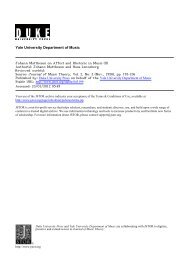Après une Lecture de Liszt: Virtuosity and ... - Free
Après une Lecture de Liszt: Virtuosity and ... - Free
Après une Lecture de Liszt: Virtuosity and ... - Free
Create successful ePaper yourself
Turn your PDF publications into a flip-book with our unique Google optimized e-Paper software.
19THCENTURYMUSICposer. Not surprisingly, the manuscripts forthe “Dante” Sonata indicate that his workingmethods did not alter <strong>de</strong>cisively as <strong>Liszt</strong> assumedhis duties as Kapellmeister in 1848 <strong>and</strong>began to change his goals <strong>and</strong> aspirations aswell as his instrument (from piano to orchestra).When his professional i<strong>de</strong>ntity changed,<strong>Liszt</strong> intensified his revision of the Sonata, revisitingthe work at least twice; but, as I willsuggest, the methods by which he continuallyrecomposed this music remain essentially themethods of a virtuoso improviser, lending thepiece a problematic status within the normativecategories of work <strong>and</strong> improvisation. Wecan extrapolate from this that the various stagesof revision to the “Dante” Sonata—like theletter to Carl Alexan<strong>de</strong>r—document <strong>Liszt</strong>’s <strong>de</strong>sireto exceed the category of virtuoso <strong>and</strong> gainacceptance as a composer within the post-Beethovenian canon.Debating Musical Legitimacy:PHANTASIEREN <strong>and</strong> KOMPONIERENAs a composer, <strong>Liszt</strong> had endured acrimony inthe press ever since 1837, when he lambastedthe music of his rival Sigismond Thalberg as“pretentiously empty <strong>and</strong> mediocre . . . supremelymonotonous <strong>and</strong> therefore supremelyboring” in the Revue et Gazette musicale <strong>de</strong>Paris. 26 At the time, he misjudged the severityof responses this would elicit from the Parisianbeau mon<strong>de</strong>, anticipating Fétis’s vengeful articlewith the throwaway remark to Maried’Agoult that the journalistic ping pong “couldall become very amusing.” 27 Recent studies of26“Prétentleusement vi<strong>de</strong>s et médiocres . . . souverainementmonotone, et partant souverainement ennuyeuse” (<strong>Liszt</strong>,“Revue critique: M. Thalberg.—Gr<strong>and</strong> Fantasie, oeuvre22.—1 er et 2 e Caprices, œuvres 15 et 19,” La Revue etGazette musicale <strong>de</strong> Paris 4 [8 Jan. 1837], 17–20, here 19).27“Cela pourra <strong>de</strong>venir amusant” (<strong>Liszt</strong> to Marie d’Agoult,13 Feb. 1837, Paris, in Correspondance / Franz <strong>Liszt</strong>, Maried’Agoult, p. 265). Fétis’s first response to <strong>Liszt</strong>’s public<strong>de</strong>nigration of Thalberg’s Gran<strong>de</strong> Fantasie, op. 22, appearedin Vert-vert on 16 January 1837. His more exten<strong>de</strong>d, comparativearticle—“MM. Thalberg et <strong>Liszt</strong>”—was publishedin La Revue et Gazette musicale 17 (23 April 1837), pp.135–42. <strong>Liszt</strong> failed to avert a thorny public dialogue byresponding: “A M. le Professeur Fétis,” Revue 20 (14 May1837), 169–72; <strong>and</strong> he was in turn answered by Fétis asecond time: “A monsieur le directeur <strong>de</strong> la Gazette Musicale<strong>de</strong> Paris,” Revue 21 (21 May 1837), 173–75.the <strong>Liszt</strong>-Thalberg rivalry showed the extent towhich <strong>Liszt</strong> had miscalculated, 28 <strong>and</strong> in thislight his appointment a <strong>de</strong>ca<strong>de</strong> later as Hof-Kapellmeister to the court of Weimar can beviewed as a much-nee<strong>de</strong>d public endorsementof his status as a composer through the court’sinstitutional pedigree. Schumann’s oft-citedcomment on the <strong>Liszt</strong> “problem,” however,remains typical in its marking of a disjuncturebetween i<strong>de</strong>ntities: “While [<strong>Liszt</strong>] <strong>de</strong>veloped hispiano playing to an extraordinary <strong>de</strong>gree, thecomposer in him lagged behind; this alwaysleads to disparity [Mißverhältnis], the consequencesof which are felt in his most recentworks.” 29 Charles Rosen articulates the mo<strong>de</strong>rnequivalent of this influential view when hei<strong>de</strong>ntifies a passage from <strong>Liszt</strong>’s tenth HungarianRhapsody as “the zero <strong>de</strong>gree of musicalinvention if we insist that invention must consistof melody, rhythm, harmony, <strong>and</strong> counterpoint.”For Rosen, <strong>Liszt</strong>’s music is “conceivedabsolutely for public performance,” 30 <strong>and</strong> thepersuasiveness of his remarks <strong>de</strong>rives partlyfrom their congruity with <strong>Liszt</strong>’s documente<strong>de</strong>xperience as an improvising <strong>and</strong> embellishingperformer as opposed to a formally trained composer.Back in 1839, Schumann explicitly un<strong>de</strong>rscoredthis point, reminding his Neue Zeitschriftrea<strong>de</strong>rs that <strong>Liszt</strong> had received scantformal instruction in composition. 31 This lack28See Rainer Kleinertz, “Subjektivität und Öffentlichkeit:<strong>Liszt</strong>s Rivalität mit Thalberg und ihre Folgen,” in Derjunge <strong>Liszt</strong>: Referate <strong>de</strong>s 4. Europäischen <strong>Liszt</strong>-Symposions:Wien 1991, ed. Gottfried Scholz (Munich: Musikverlag E.Katzbichler, 1993); Gooley, “<strong>Liszt</strong>, Thalberg <strong>and</strong> the ParisianPublics,” in The Virtuoso <strong>Liszt</strong>, pp. 18–77; ChristopherH. Gibbs, “‘Just Two Words. Enormous Success’:<strong>Liszt</strong>’s 1838 Vienna Concerts,” in Franz <strong>Liszt</strong> <strong>and</strong> HisWorld, ed. Gooley <strong>and</strong> Gibbs (Princeton: Princeton UniversityPress, 2006), pp. 167–230.29“Brachte er [<strong>Liszt</strong>] es nun als Spieler auf eine erstaunlicheHöhe, so war doch <strong>de</strong>r Komponist zurückgeblieben, undhier wird immer ein Mißverhältnis entstehen, das sichauffallend auch bis in seine letzten Werke fortgerächt hat.”Schumann’s comment occurs in his 1839 review of pianoétu<strong>de</strong>s, including <strong>Liszt</strong>’s Étu<strong>de</strong> en douze exercices (op. 1)<strong>and</strong> their recomposition as twelve Gran<strong>de</strong>s étu<strong>de</strong>s. Translationadapted from Schumann, On Music <strong>and</strong> Musicians,trans. Paul Rosenfeld, ed. Konrad Wolff (New York: Pantheon,1946), p. 147.30Charles Rosen, The Romantic Generation (Bath: Fontana,1996), p. 507.31“Zu anhalten<strong>de</strong>n Studien in <strong>de</strong>r Komposition scheint er[<strong>Liszt</strong>] keine Ruhe, vielleicht auch keinen ihm gewachsenenMeister gefun<strong>de</strong>n zu haben; <strong>de</strong>sto mehr studierte er als60



